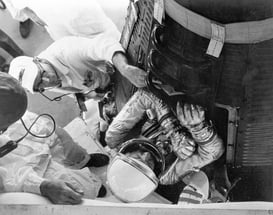 On May 5, 1961, Alan Shepard became the first US astronaut to journey to the “final frontier.” Atop a Mercury rocket, Shepard launched into a fifteen-minute suborbital journey reaching an altitude of about one hundred miles before returning to earth. His space capsule, Freedom 7, was a wonder of science weighing a little more than one ton and loaded to the max with avionics and life support apparatus. Yet, this pioneering venture into endless space would also afford almost no space for the passenger. According to launch engineer, Guenter Wendt, “astronauts entered their capsules with a shoehorn and departed with a can opener.” I remember watching footage of Shephard squeezing into his capsule. The memory still creates pangs of claustrophobia.
On May 5, 1961, Alan Shepard became the first US astronaut to journey to the “final frontier.” Atop a Mercury rocket, Shepard launched into a fifteen-minute suborbital journey reaching an altitude of about one hundred miles before returning to earth. His space capsule, Freedom 7, was a wonder of science weighing a little more than one ton and loaded to the max with avionics and life support apparatus. Yet, this pioneering venture into endless space would also afford almost no space for the passenger. According to launch engineer, Guenter Wendt, “astronauts entered their capsules with a shoehorn and departed with a can opener.” I remember watching footage of Shephard squeezing into his capsule. The memory still creates pangs of claustrophobia.
Ironically, space constraints faced by NASA fueled a revolution in miniaturization evident in almost every innovation of modern society – from laptops to cell phones to transportation to medical devices to all things Internet. The need to pack more utility into a small package has changed everything. Or almost everything. Here are some recent exceptions:
“We’re adding a new wing to manufacturing,” a colleague related to me recently, “we’re running out of space.” As I glanced around a shop floor crowded more with material than machines, I asked, “What are you going to put in the new space?” “We’re just going to spread out,” he said. “This is a good time to build before interest rates start to climb.”
Another manufacturer advised recently that he was building a Lean warehouse. “What’s that?” I asked. “We’re relocating all of our raw material to a location that’s closer to the main highway,” he said. “We need to add several machines, so were Lean-ing out the space.” “Aren’t you just adding more space and moving inventory farther from your floor?” I asked. His response: “Warehouse space is cheap.”
A major hospital requested Lean assistance to re-design its perinatal services in order to accommodate more patients. After reviewing the current operation, I recommended that existing space could be repurposed to handle the projected growth. “No,” they said, “We’re cramped. We need more space and the budget is already approved.”
It seems that decisions regarding space are driven more by claustrophobia or perceived worth than actual need. Flow distance may double or triple as a result of expansion, but additional space somehow still equates to growth. More space is viewed as an investment, an alluring addition to the balance sheet, or a badge of success. Only on rare occasions do I encounter a growing business that is interested in reducing space. Perhaps, then, space is the final frontier. Not more space, but less. I wonder how much Lean progress would be made if space were seen as a constraint for business as it was for NASA’s Mercury launch.
How much space do you have? Too much? Too little? Share a story.
O.L.D.
PS I'm teaching the Shingo Institute workshop "Continuous Improvement" at MassMutual in Springfield next week and a few seats remain if you'd like to join us. Learn more here.
PPS I'm also looking forward to presenting my monthly "Tea Time with The Toast Dude" webinar on June 20th. It's free! The topic is "Silver Bullet Mania". Intrigued? Read more and register here.



 On May 5, 1961, Alan Shepard became the first US astronaut to journey to the “final frontier.” Atop a Mercury rocket, Shepard launched into a fifteen-minute suborbital journey reaching an altitude of about one hundred miles before returning to earth. His space capsule, Freedom 7, was a wonder of science weighing a little more than one ton and loaded to the max with avionics and life support apparatus. Yet, this pioneering venture into endless space would also afford almost no space for the passenger. According to launch engineer, Guenter Wendt, “astronauts entered their capsules with a shoehorn and departed with a can opener.” I remember watching footage of Shephard squeezing into his capsule. The memory still creates pangs of claustrophobia.
On May 5, 1961, Alan Shepard became the first US astronaut to journey to the “final frontier.” Atop a Mercury rocket, Shepard launched into a fifteen-minute suborbital journey reaching an altitude of about one hundred miles before returning to earth. His space capsule, Freedom 7, was a wonder of science weighing a little more than one ton and loaded to the max with avionics and life support apparatus. Yet, this pioneering venture into endless space would also afford almost no space for the passenger. According to launch engineer, Guenter Wendt, “astronauts entered their capsules with a shoehorn and departed with a can opener.” I remember watching footage of Shephard squeezing into his capsule. The memory still creates pangs of claustrophobia.
